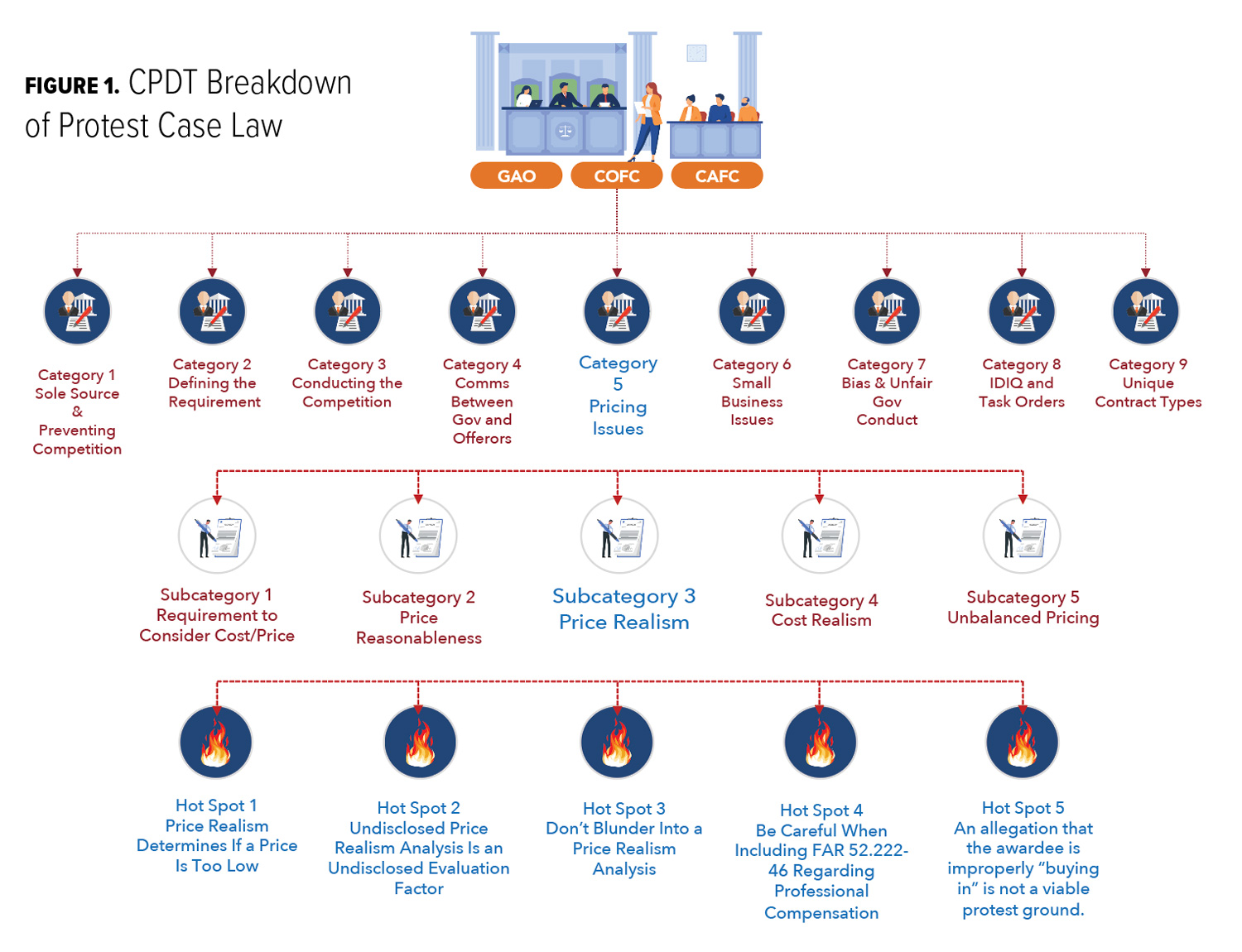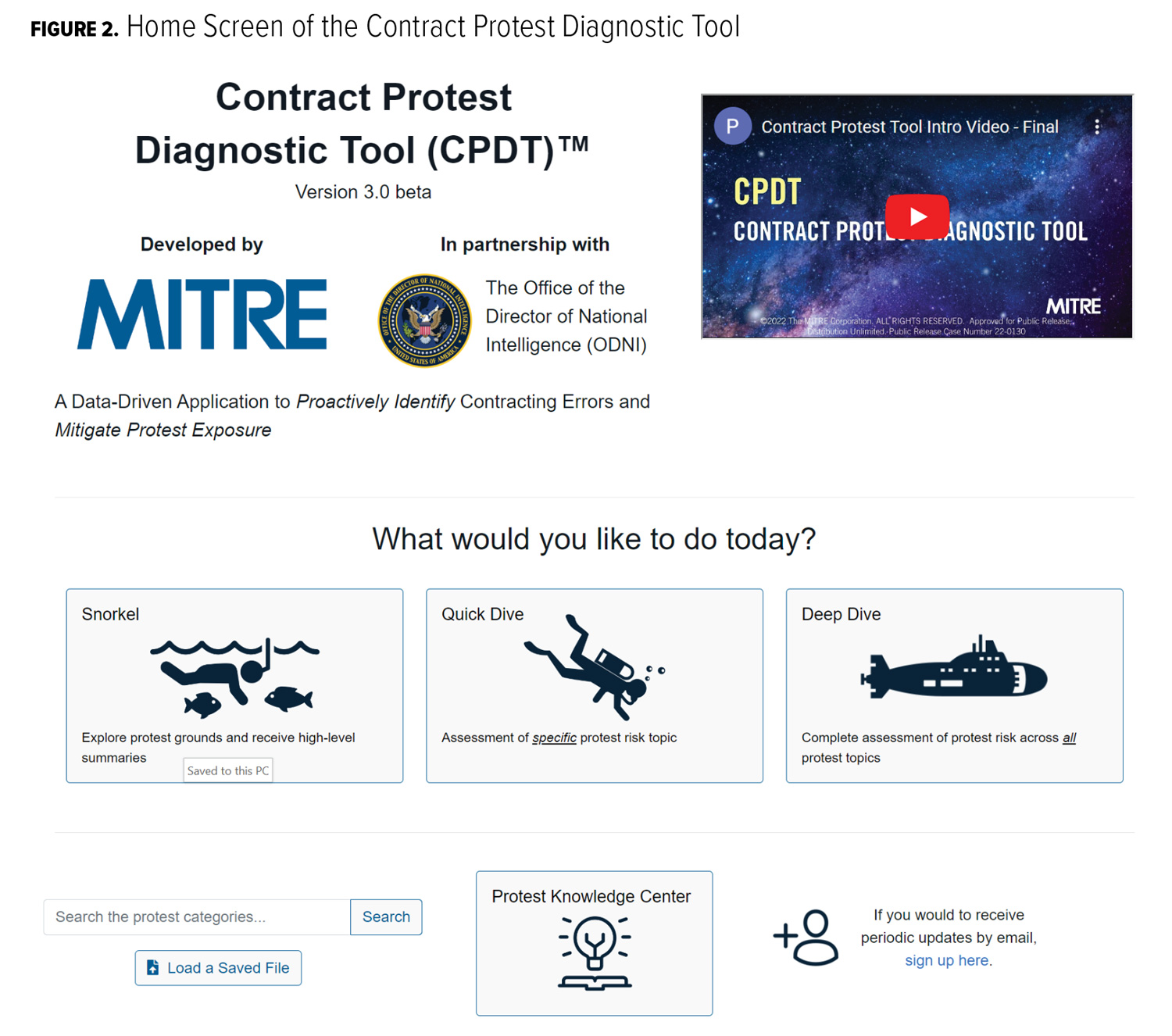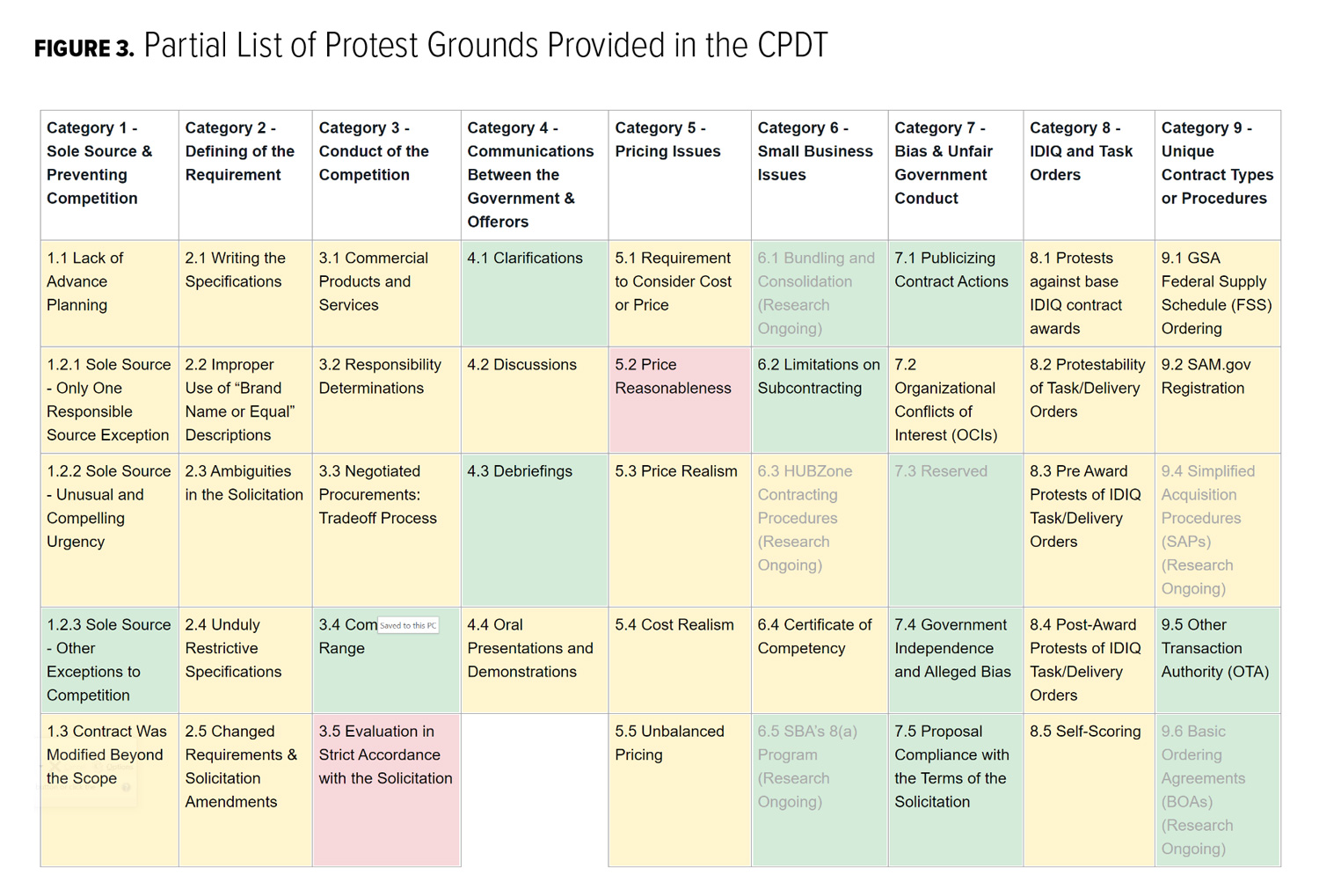A New Tool to Help Avoid Bid Protest Pitfalls: The Contract Protest Diagnostic Tool
By Patrick Staresina, CPCM, CFCM and Patrick Butler, J.D.
.jpg) As any experienced government contracting professional knows, nothing can throw a wrench in the gears of a complex procurement like the dreaded bid protest. Even a protest that lacks merit can lead to costly delays to the contract schedule, often requiring the contracting officer to scramble to get a “bridge contract” in place, and can quickly absorb the one resource that most contracting officers don’t have – time.
As any experienced government contracting professional knows, nothing can throw a wrench in the gears of a complex procurement like the dreaded bid protest. Even a protest that lacks merit can lead to costly delays to the contract schedule, often requiring the contracting officer to scramble to get a “bridge contract” in place, and can quickly absorb the one resource that most contracting officers don’t have – time.
If the protest has merit, it worsens the problem because it forces the agency to take corrective action or risk receiving a sustained pro- test from the Government Accountability Office (GAO) or the Court of Federal Claims (COFC). Even a protest that GAO denies can be filed anew at the COFC. Further, the Court of Appeals for the Federal Circuit (CAFC) can overrule a COFC decision that denied the protest. In other words, a protest can mire the agency in litigation, adding significant costs and delays to the contract’s formation.
On the other side are the contractors – including the protester and the new awardee. Contractors are looking for a fair chance to compete for government requirements and expect the agency to comply with applicable procurement laws, regulations, case law, and the terms of the solicitation.
Losing a fairly conducted competition is one thing, but losing because the agency made an error in the evaluation process often forces a contractor’s hand. Although most contractors are reluctant to spend valuable corporate resources to litigate a protest, sometimes they are left with little choice.
Protests also inflict significant pain on the company awarded the contract as they try to manage through a lengthy “stop work” order. Even worse, the awardee may ultimately lose the contract they thought they had won.
A Mountain of Bid Protest Decisions
Compounding the problem is that there are thousands of bid protest decisions – dating back decades – that contracting officers need to be aware of as they move through the contract formation process.
Although some protest decisions involve a straightforward application of the facts to the Federal Acquisition Regulation (FAR), other protest decisions create rules that are not evident from the plain text of the FAR. Further, new decisions are published daily, challenging even the most experienced contracting professional to stay current. Unlike statutes and the FAR – both readily accessible by the workforce – protest decisions are much more difficult to access, understand, and apply.

Introducing the CPDT
In response to this challenge, the MITRE Corporation, in partnership with the Office of the Director of National Intelligence (ODNI), created an innovative capability called the Contract Protest Diagnostic Tool (CPDT).
The CPDT is an innovative tool designed to help users access and understand bid process decisions. It is a 100% free online tool that breaks down the most common bid protest grounds into nine main “categories” comprised of 64 separate “subcategories.”
The CPDT breaks the subcategories into “Hot Spots,” which alert users to risky protest areas. Underneath each “Hot Spot,” the user can click on the protest decisions that inform the “plain English” explanation in the Hot Spot. The goal is to allow users to quickly cut through the fog and zero in on their protest topic and its corresponding decisions.
The CPDT also has a questionnaire-based functionality, allowing users to plug in information from real-world contracting actions to identify the applicable protest rules/decisions at play. The user can apply the questionnaire to the entire contracting action (a “deep dive”) or to just the subcategories that a contracting professional is worried about (a “quick dive”). Finally, the CPDT includes a “Protest Knowledge Center” that gathers publicly available protest information (including blog posts and news feeds) into one centralized location.

Evolution of the CPDT
The CPDT began in 2020 in response to MITRE’s Innovation Program (MIP), which seeks submissions for new ideas that can solve important problems for the federal government. The CPDT principal investigator/project leader, Patrick “Pat” Staresina, submitted the proposal after reflecting on the challenges he faced during his 23-year career as a Department of Defense contracting officer.
Like most contracting officers, he understood the FAR very well but grappled with the high volume of protest decisions he needed to digest when faced with challenging contracting problems. In his experience, no pragmatic resource was available that made bid protest decisions more accessible and understandable to the acquisition workforce.
His proposal for the CPDT was among those selected for funding through MITRE’s independent research and development program, which enabled Staresina to start developing the project with the assistance of experienced federal contract attorneys.
Recognizing the need and potential for this tool, MITRE connected with Daniel Finkenstadt, who was serving as a professor at the Naval Postgraduate School (NPS) in 2021. Professor Finkenstadt immediately recognized both the need and potential for this tool. His support led to a Cooperative Research & Development Agreement (CRADA) between NPS and MITRE designed to refine the tool with help from Finkenstadt’s class of 20 Air Force acquisition professionals.
Finkenstadt explained:
We recognized two things about [the] CPDT right away: 1) its promise in helping the workforce navigate an extremely complex topic – protest types, causes, and mitigations, and 2) its ability to access rich detail with minimal cognitive load on the user. Similar to TurboTax, it allows the user to explain their situation vs. knowing their areas of concern in advance. It serves as a legal guide for those seeking to be proactive in acquisition strategy design or as a support for those responding to the disruptive nature of contract protests. This can protect [both] the buyer and the seller. Buyers get better at building clearer requirements, instructions, decision processes, and public communications, while the sellers benefit from a clearer understanding of a typically opaque government decision-making process. As a nice secondary feature, we in research use it to target areas of concern for further exploration in our research projects. (1)
After developing and validating the initial prototype, the most challenging part came next: finding a champion to sponsor the remaining research and assist in operationalizing the tool. As with most research projects, the project team had to knock on many doors and provide a lot of research pitches to find that champion. Luckily, the CPDT Project Team provided a demonstration to Scott Bumgarner, the Senior Procurement Executive for the Intelligence Community (IC). During that exchange, Bumgarner recognized the tool’s usefulness to the IC acquisition community.
Bumgarner explained:
Of the many benefits of the tool, one of the most intriguing involves the ability to more precisely identify and calibrate areas of heightened risk in the acquisition process. These powerful insights, in turn, can help practitioners avoid the temptation of applying overly restrictive source selection approaches grounded in unwarranted risk aversion fears. (2)
Bumgarner championed the CPDT and helped organize a pilot program in 2022 with members of the IC’s legal and contracting communities. The feedback from that pilot program further strengthened this capability, paving the way for the CPDT to “go live” under contract with ODNI for the IC Acquisition Workforce in late 2022.

A Valuable Capability Growing Stronger
The CPDT is still technically a prototype (with some categories under construction), but it contains valuable information and analysis to help the contracting community today. Further, it tackles complicated areas such as “Price Realism,” “GSA Schedule Contracting,” and “Self-Scoring.”
The goal is to complete all “under construction” areas by the end of the 2024 calendar year. Since bid protest decisions come out daily, the plan moving forward is to analyze them as they are published to update the tool swiftly.
Conclusion
Although acquisition professionals have easy access to statutes and regulations (e.g., the FAR), they lack that same level of access to bid protest decisions. These decisions are important because they form part of the law governing contract formation. The absence of a readily available resource for accessing and understanding them increases the risk that agencies will inadvertently fall into a protest pitfall.
On the other end of the spectrum, this knowledge gap can lead to agencies taking overly risk-averse decisions based on perceived protest risks that may not be warranted. The CPDT provides a sensible and practical solution to bridge this knowledge gap. CM
The information presented in this article is up to date as of February 2024. To see the most recent version of The CPDT, visit https://aida.mitre.org/protest-tool/.
Patrick Staresina, CPCM, CFCM, is an Acquisition Principal and Group Leader for The MITRE Corporation, providing high-level acquisition support to help solve some of the government’s most complex acquisition problems. Before his employment at MITRE, Staresina served 31 years in the Army and Army National Guard, retiring at the rank of Colonel as the Chief of Operational Contracting at the National Guard Bureau. He has over 23 years of contracting officer experience.
Patrick Butler, J.D., is an attorney and independent consultant. He founded PBI Consulting, LLC, which provides SME-level acquisition support to federal agencies. Butler is currently the primary legal researcher and writer (as an independent contractor) for the MITRE Corporation’s Contract Protest Diagnostic Tool. He served for 21 years as an Army JAG officer, with most of his assignments focused on contract and fiscal law. He retired as a Colonel in the fall of 2021.
ENDNOTES
1 Finkenstadt, Daniel. Email to Patrick Staresina. 8 November 2023.
2 Bumgarner, Thomas Scott. Email to Patrick Staresina. 6 November 2023.